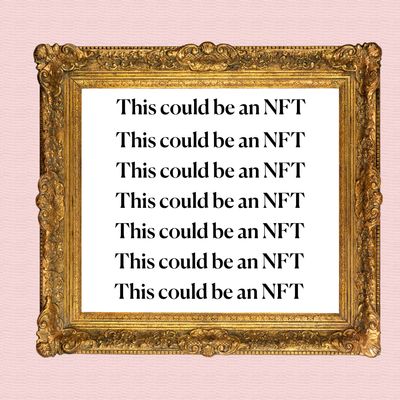
Let me guess: You’ve been trying your hardest to ignore the subject of NFTs, but it’s gotten to the point where conversations about them seem impossible to avoid, and you want to be able to keep up.
I can sympathize. A few weeks ago, I finally thought: Okay, I’ll bite. What are NFTs, and why the heck are people paying so much money for them?? But whenever someone tried to explain them to me, they’d usually start off with “Basically …” and then say something that might as well be in another language. Online explainers were just as bad, so I decided to take matters into my own hands and figure it out by piecing together conversations with a handful of experts.
To be clear: I still have no idea what I’m talking about. There are far more thorough, far more accurate explainers out there, if you’re really interested. But if you’re looking for one that uses Phantom Thread analogies and doesn’t take itself too seriously, then you’re in the right place. My hope is that after reading this, you can confidently meet someone halfway on the subject. But no more than that.
What does NFT stand for?
NFT stands for ‘non-fungible token.’
Excuse me?
I know, ‘fungible’ is a ridiculous-sounding word. Basically, it means ‘interchangeable.’ Like if we swapped quarters, we’d both still have 25 cents. A non-fungible token is unique, and cannot be traded one-to-one. Think of it like the haute couture of currency; each NFT is exclusive to its owner.
Okay, so how do I get my hands on one?
Unlike couture gowns, NFTs don’t exist in the physical world. They’re strictly digital assets made up of unique lines of code that are stored on something called the “blockchain,” which is like an immutable digital ledger, or, a receipt written in stone. You need cryptocurrency to buy one, specifically Ethereum.
None of that made sense. This is where I stop paying attention.
Fair. Stay with me, though, because I’m not even going to try to explain to you what the blockchain is, or how it works. And I promise not to use the word “Ethereum” again.
Fine. Please continue.
Okay, since we’ve already used haute couture as a metaphor, allow me to try to use the plot of Phantom Thread as a reference point, just for kicks. (If you haven’t watched it, please exit this window and do so before reading any further.) Remember when Reynolds Woodcock designs a custom wedding dress for the Princess of Whatever? That gown is one-of-a-kind. It is non-fungible. Even if someone were to make an exact copy of it, only the princess would have the original, which has “never cursed” sewn into its seam — effectively Woodcock’s signature.
Now. Imagine that Phantom Thread takes place in the year 2021. To get with the times, the House of Woodcock is selling digital renderings of a gowns. Cool. The only problem is that they can’t call this type of work haute couture. Why? Because digital assets are fungible. If Woodcock saved the finished project to his desktop — let’s call the file WeddingDress.jpg — it could be copied a million times and sent to a million different people, and everyone would have the same thing.
This is where NFTs come in. As luck would have it, there’s a princess out there who loves Woodcock’s work, thinks it’s fucking chic, and wants to own an image of it. She is rich in cryptocurrency, but she’s only going to pay for a JPEG file if she’s able to say with absolute certainty that she alone owns the original, nobody else. So instead of buying WeddingDress.jpg, she buys an NFT of the file, which Cyril has put up for auction on a digital NFT marketplace like this one, under the username is Oldsoandso.
Without getting too much into the tech, what the princess has purchased isn’t the file itself. What’s she’s purchased instead is basically a digital certificate of authenticity that says, in code: “Oldsoandso transferred the ownership of this file to me on this date for this much money.” That receipt, which was “minted” on the blockchain, where it cannot be deleted, duplicated, or messed with, is the non-fungible-haute-couture token and thing of value. It’s as if Woodcock wrote “never cursed” in computer language, and sewed it into the image of the dress.
I see, so this is really about manufacturing exclusivity.
Exactly! It’s about having proof that you own the “original” or “real” version of a digital asset. And that digital asset could be anything: A tweet, a GIF of a flying cat, an NBA highlight-reel video, even a photo of this very article. A Times writer recently auctioned off a photo of his article about NFTs for $560,000.
To use another movie reference, it’s sort of like in A Walk to Remember, when that guy buys a star for Mandy Moore. What he really bought was a piece of paper giving him the right to name the star, not the star itself. No one can really “own” a star, in the same way that no one can really “own” a tweet. We can all go online, or look up in the night sky, and see them for ourselves. That piece of paper, though, serves as something like an NFT.
It makes sense now why I keep hearing about NFTs in relation to artwork.
Yes. Verifying an artwork as an original has always been important to the art market. There’s never really been a way to do that with digital art before, though, so here we are.
Things have escalated quickly, in part because the market for original artwork is so well-established. In March, an NFT of a collage by the digital artist known as Beeple sold for $69 million at Christie’s, positioning him “among the top three most valuable living artists,” according to the auction house. So the list goes: David Hockney, Jeff Koons, and then … Beeple.
Why are people paying $69 million for an NFT, though?
For the same reasons people pay lots of money for rare baseball cards, uncut gems, and, of course, haute couture dresses. Maybe they genuinely love the thing, and want to support the person who created it. (Bret Easton Ellis?) Maybe they think it’s a good investment. Maybe they have too much money and think it’s funny. Or maybe they just want bragging rights. Either way, humans just like to own stuff, even if it’s not material.
There’s also a certain aura to an original — something works of art have arguably lost in the Age of Mechanical Reproduction. “Now that there is a way to tether originality to digital objects, the question becomes: Does the minted original have any more aura than a copy of the digital file, or a screenshot of it?” asked Lauren Studebaker, an internet art researcher and writer. “In terms of ownership, it’s an ideological thing,” she said.
Personally, I would like to own an NFT of this extremely awkward Vine that Times chief fashion critic Vanessa Friedman took of the Olsen twins in 2014.
Besides money, do the sellers get anything out of it?
If you’re an artist or creator, there are some benefits to NFTs. “The concept of ownership (and therefore materiality) that an NFT provides an object could further legitimize art made using digital means to the general public as being equal to, let’s say, paintings,” said Studebaker.
Creators also have the ability to write clauses into their NFTs. Beeple, for example, stipulated that he earn a 10 percent royalty off of each consequent resale of his $69 million piece. “It’s an issue in the art world, where a young artist will sell their work at an undervalued rate because they have to get by, and then in a year or two, the buyer resells it for a huge profit,” Studebaker explained.
She also added that when it comes to music, artists could start minting songs as NFTs, allowing them to set the price for subsequent streams, which don’t currently yield as much profit as buying a CD, or a song on iTunes did. They could also sell original recordings, mint concert tickets as NFTs to avoid scalping, etc. There are a million different ways artists can benefit from NFTs, from musicians to meme makers.
Hmm. I think I ‘ve got the gist of it. Now I want to argue.
Great! Arguing about NFTs is the easiest part. In my experience, simply saying those three letters in a row can be enough to upset someone, specifically a self-serious person who knows what Ethereum means. (God help me after these Phantom Thread analogies.) But for all the jargon and bullshit surrounding NFTs, the subject can actually bring up some interesting questions.
For example, my friend Alexander Iadarola recently sold an NFT of a digital smiley face he made, but got shadow-banned from an invite-only platform when he tried to sell a photo of his foot. This is a great fodder for intellectual debate: Does one qualify as “art” more than the other? Who’s to say? What if it was a really good foot??
Another thing people love to argue about is where this is going. Is it just a bubble? A fad? Or are we going to be talking about NFTs for the REST OF OUR LIVES??? (Or are they going to kill the planet first?) The current hype will likely die down, but there’s a world in which NFTs could be a common, boring thing. No one knows the answer.
Okay, so how much for an NFT of this article?
Wow, thank you so much for asking! Let’s talk offline.





